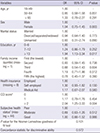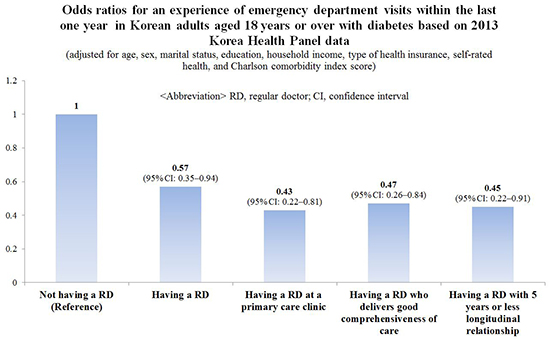2. Carls G, Huynh J, Tuttle E, Yee J, Edelman SV. Achievement of glycated hemoglobin goals in the US remains unchanged through 2014. Diabetes Ther. 2017; 8:863–873.
4. Peterson KA, Radosevich DM, O’Connor PJ, Nyman JA, Prineas RJ, Smith SA, Arneson TJ, Corbett VA, Weinhandl JC, Lange CJ, et al. Improving diabetes care in practice: findings from the TRANSLATE trial. Diabetes Care. 2008; 31:2238–2243.
5. Mostashari F, Sanghavi D, McClellan M. Health reform and physician-led accountable care: the paradox of primary care physician leadership. JAMA. 2014; 311:1855–1856.
6. Kiran T, Glazier RH, Campitelli MA, Calzavara A, Stukel TA. Relation between primary care physician supply and diabetes care and outcomes: a cross-sectional study. CMAJ Open. 2016; 4:E80–E87.
7. Starfield B, Shi L, Macinko J. Contribution of primary care to health systems and health. Milbank Q. 2005; 83:457–502.
8. Manns BJ, Tonelli M, Zhang J, Campbell DJ, Sargious P, Ayyalasomayajula B, Clement F, Johnson JA, Laupacis A, Lewanczuk R, et al. Enrolment in primary care networks: impact on outcomes and processes of care for patients with diabetes. CMAJ. 2012; 184:E144–E152.
9. Lee JH, Choi YJ, Volk RJ, Kim SY, Kim YS, Park HK, Jeon TH, Hong SK, Spann SJ. Defining the concept of primary care in South Korea using a Delphi method. Fam Med. 2007; 39:425–431.
10. Starfield B. Primary Care: Balancing Health Needs, Services, and Technology. New York, NY: Oxford University Press;1998.
11. Ionescu-Ittu R, McCusker J, Ciampi A, Vadeboncoeur AM, Roberge D, Larouche D, Verdon J, Pineault R. Continuity of primary care and emergency department utilization among elderly people. CMAJ. 2007; 177:1362–1368.
12. Tiagi R, Chechulin Y. The effect of rostering with a patient enrolment model on emergency department utilization. Healthc Policy. 2014; 9:105–121.
13. Brown AD, Goldacre MJ, Hicks N, Rourke JT, McMurtry RY, Brown JD, Anderson GM. Hospitalization for ambulatory care-sensitive conditions: a method for comparative access and quality studies using routinely collected statistics. Can J Public Health. 2001; 92:155–159.
14. Tsai AC, Morton SC, Mangione CM, Keeler EB. A meta-analysis of interventions to improve care for chronic illnesses. Am J Manag Care. 2005; 11:478–488.
15. McCusker J, Roberge D, Lévesque JF, Ciampi A, Vadeboncoeur A, Larouche D, Sanche S. Emergency department visits and primary care among adults with chronic conditions. Med Care. 2010; 48:972–980.
16. Hussey PS, Schneider EC, Rudin RS, Fox DS, Lai J, Pollack CE. Continuity and the costs of care for chronic disease. JAMA Intern Med. 2014; 174:742–748.
17. Hong JS, Kang HC, Kim J. Continuity of care for elderly patients with diabetes mellitus, hypertension, asthma, and chronic obstructive pulmonary disease in Korea. J Korean Med Sci. 2010; 25:1259–1271.
18. Horwitz DA, Schwarz ES, Scott MG, Lewis LM. Emergency department patients with diabetes have better glycemic control when they have identifiable primary care providers. Acad Emerg Med. 2012; 19:650–655.
19. Hearld LR, Alexander JA. Patient-centered care and emergency department utilization: a path analysis of the mediating effects of care coordination and delays in care. Med Care Res Rev. 2012; 69:560–580.
20. Stern Z, Calderon-Margalit R, Mazar M, Brezis M, Tirosh A. Emergency room visit: a red-flag indicator for poor diabetes care. Diabet Med. 2009; 26:1105–1111.
21. Grumbach K, Keane D, Bindman A. Primary care and public emergency department overcrowding. Am J Public Health. 1993; 83:372–378.
22. Chai YS, Lee JK, Park SS, Kim HJ, Kang IG, Kim HS, Lee MS, Hong JY, Lee MJ. Use of emergency medical services and characteristics of urgent and non-urgent adult patients according to the usual source of care: a Korea Medical Expenditure Panel Study. J Korean Soc Emerg Med. 2015; 26:129–137.
23. An AR, Kim K, Lee JH, Sung NJ, Lee SI, Hyun MK. Having a usual source of care and its associated factors in Korean adults: a cross-sectional study of the 2012 Korea Health Panel Survey. BMC Fam Pract. 2016; 17:167.
25. Charlson ME, Pompei P, Ales KL, MacKenzie CR. A new method of classifying prognostic comorbidity in longitudinal studies: development and validation. J Chronic Dis. 1987; 40:373–383.
26. Deyo RA, Cherkin DC, Ciol MA. Adapting a clinical comorbidity index for use with ICD-9-CM administrative databases. J Clin Epidemiol. 1992; 45:613–619.
27. Quan H, Sundararajan V, Halfon P, Fong A, Burnand B, Luthi JC, Saunders LD, Beck CA, Feasby TE, Ghali WA. Coding algorithms for defining comorbidities in ICD-9-CM and ICD-10 administrative data. Med Care. 2005; 43:1130–1139.
28. Jung KW, Won YJ, Kong HJ, Oh CM, Shin A, Lee JS. Survival of Korean adult cancer patients by stage at diagnosis, 2006–2010: national cancer registry study. Cancer Res Treat. 2013; 45:162–171.
29. Kim KM, Jeon H, Lee JH. Having a physician rather than a place as a usual source of care would be better — from 2012 Korea Health Panel data. J Korean Med Sci. 2017; 32:4–12.
30. Schoen C, Osborn R, Doty MM, Bishop M, Peugh J, Murukutla N. Toward higher-performance health systems: adults’ health care experiences in seven countries, 2007. Health Aff (Millwood). 2007; 26:w717–w734.
31. Organisation for Economic Co-operation and Development. OECD reviews of health care quality: Korea 2012—raising standards [Internet]. accessed on 3 July 2017. Available at
http://dx.doi.org/10.1787/9789264173446-en.
32. Mossialos E, Djordjevic A, Osborn R, Sarnak D. International Pofiles of Health Care Systems. New York, NY: The Commonwealth Fund;2017.
33. Organisation for Economic Co-operation and Development. OECD health care quality review: Korea—assessment and recommendations [Internet]. accessed on 2 July 2017. Available at
http://www.oecd.org/korea/49818570.pdf.
34. Pourat N, Davis AC, Chen X, Vrungos S, Kominski GF. In California, primary care continuity was associated with reduced emergency department use and fewer hospitalizations. Health Aff (Millwood). 2015; 34:1113–1120.
35. Haggerty JL, Roberge D, Pineault R, Larouche D, Touati N. Features of primary healthcare clinics associated with patients’ utilization of emergency rooms: urban-rural differences. Healthc Policy. 2007; 3:72–85.
36. McCusker J, Tousignant P, Borgès Da Silva R, Ciampi A, Lévesque JF, Vadeboncoeur A, Sanche S. Factors predicting patient use of the emergency department: a retrospective cohort study. CMAJ. 2012; 184:E307–E316.
37. Carter R, Quesnel-Vallée A, Plante C, Gamache P, Lévesque JF. Effect of family medicine groups on visits to the emergency department among diabetic patients in Quebec between 2000 and 2011: a population-based segmented regression analysis. BMC Fam Pract. 2016; 17:23.
38. Wu S, Wang R, Zhao Y, Ma X, Wu M, Yan X, He J. The relationship between self-rated health and objective health status: a population-based study. BMC Public Health. 2013; 13:320.
39. Goldman N, Lin IF, Weinstein M, Lin YH. Evaluating the quality of self-reports of hypertension and diabetes. J Clin Epidemiol. 2003; 56:148–154.










 PDF
PDF ePub
ePub Citation
Citation Print
Print





 XML Download
XML Download